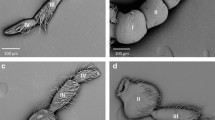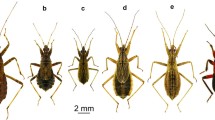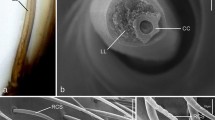Abstract
Two types of integumental compound sense organs are described in 48 of the 86 known species of euphausiids. The first occurs in the dorsal regions of the abdominal segments, especially the fourth and fifth. They consist of paired rows of short peglike setae that appear to have bifid endings and are thus probably chemoreceptors. The second type is a compound organ present in the median dorsal anterior region of the carapace. It is usually located in the apical region of a keel in front of cervical groove. Its form is different in each species and so it can be used as a diagnostic feature to identify damaged euphausiids and females where the male copulatory organ (petasma) is the principal character used to identify the species.
Similar content being viewed by others
References
Boden, B.P., M.W. Johnson andBrinton (1955): The Euphausiacea (Crustacea) of the North Pacific. Bull. Scripps Inst. Oceanogr.,6, 287–400.
Costanza, G. andL. Guglielmo (1976): Diagnostic value of the thelycum in euphausiids, I. Mediterranean species (First note). Crustaceana,31, 45–53.
Fleminger, A. (1973): Pattern, number, variability, and taxonomic significance of integumental organs (sensilla and glandular pores) in the genusEucalanus (Copepoda, Calanoida). Fishery Bull.,71, 965–1010.
Laverack, M.S. (1968): On the receptors of marine invertebrates. Oceanogr. Mar. Biol., Ann. Rev.,6, 249–324.
Laverack, M.S. (1974): The structure and function of chemoreceptor cells.In, Chemoreception in Marine Organisms, ed. byP. T. Grant andA.M. Mackie, Academic Press, London and New York, pp. 1–48.
Mauchline, J. (1977): The integumental glands and sensilla of pelagic Crustacea. J. Mar. Biol. Assoc. U.K.,57, 973–994.
Mauchline, J., Y. Aizawa, T. Ishimaru, S. Nishida andR. Marumo (1977): Integumental sensilla of pelagic decapod crustaceans. Mar. Biol.,43, 149–155.
Mauchline, J. andA. R. S. Ballantyne (1975): The integumental organs of amphipods. J. Mar. Biol. Assoc. U.K.,55, 345–350.
Nemoto, T. (1963): A new species of Euphausiacea,Thysanoëssa inspinata, from the North Pacific. J. Oceanogr. Soc. Japan,19, 41–47.
Vedel, J.P. andF. Clarac (1976): Hydrodynamic sensitivity by cuticular organs in the rock lobsterPalinurus vulgaris. Morphological and physiological aspects. Mar. Behav. Physiol.,3, 235–251.
Author information
Authors and Affiliations
Rights and permissions
About this article
Cite this article
Mauchline, J., Nemoto, T. Integumental sensilla of diagnostic value in euphausiids. Journal of the Oceanographical Society of Japan 33, 283–289 (1977). https://doi.org/10.1007/BF02109647
Received:
Revised:
Accepted:
Published:
Issue Date:
DOI: https://doi.org/10.1007/BF02109647




